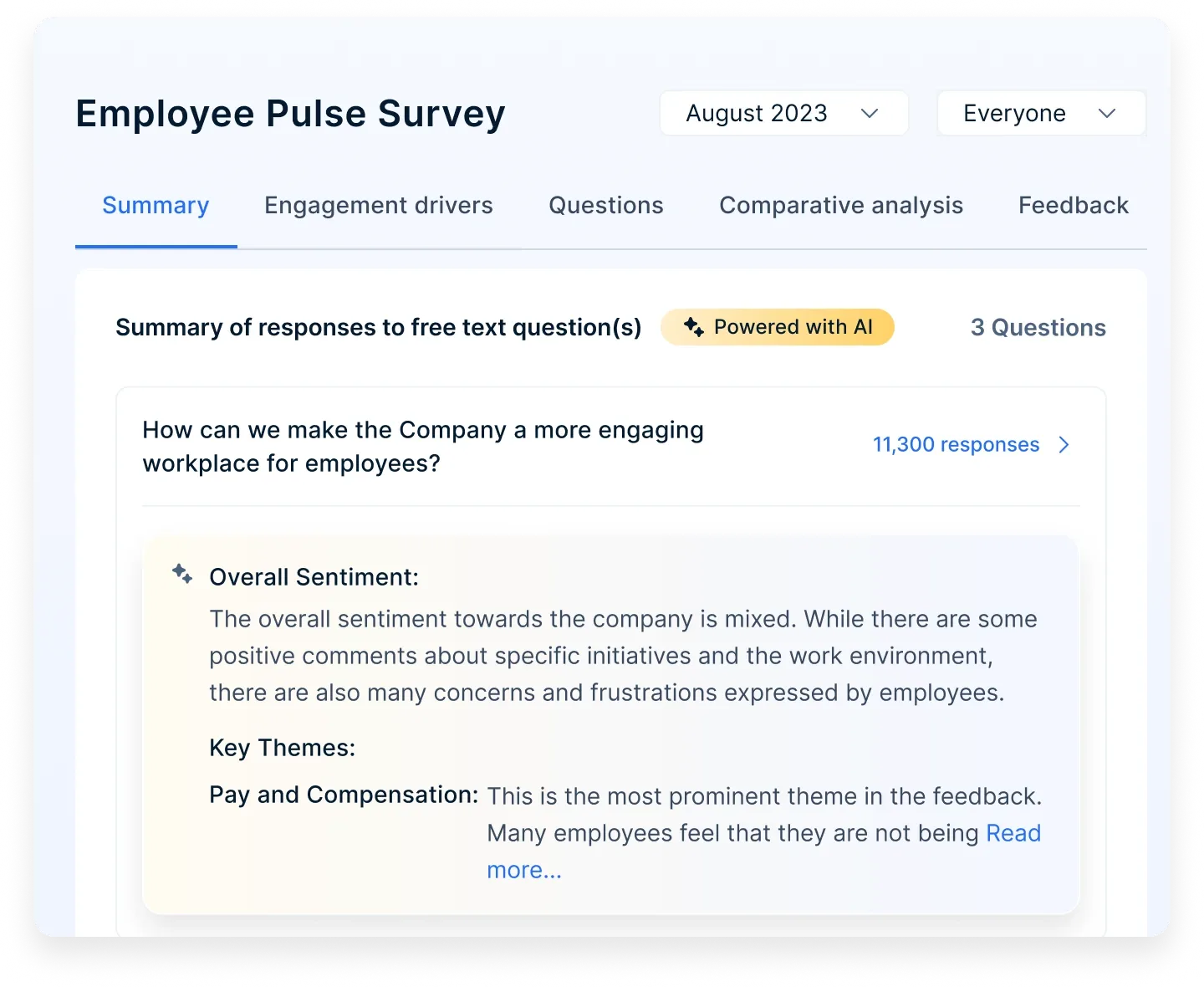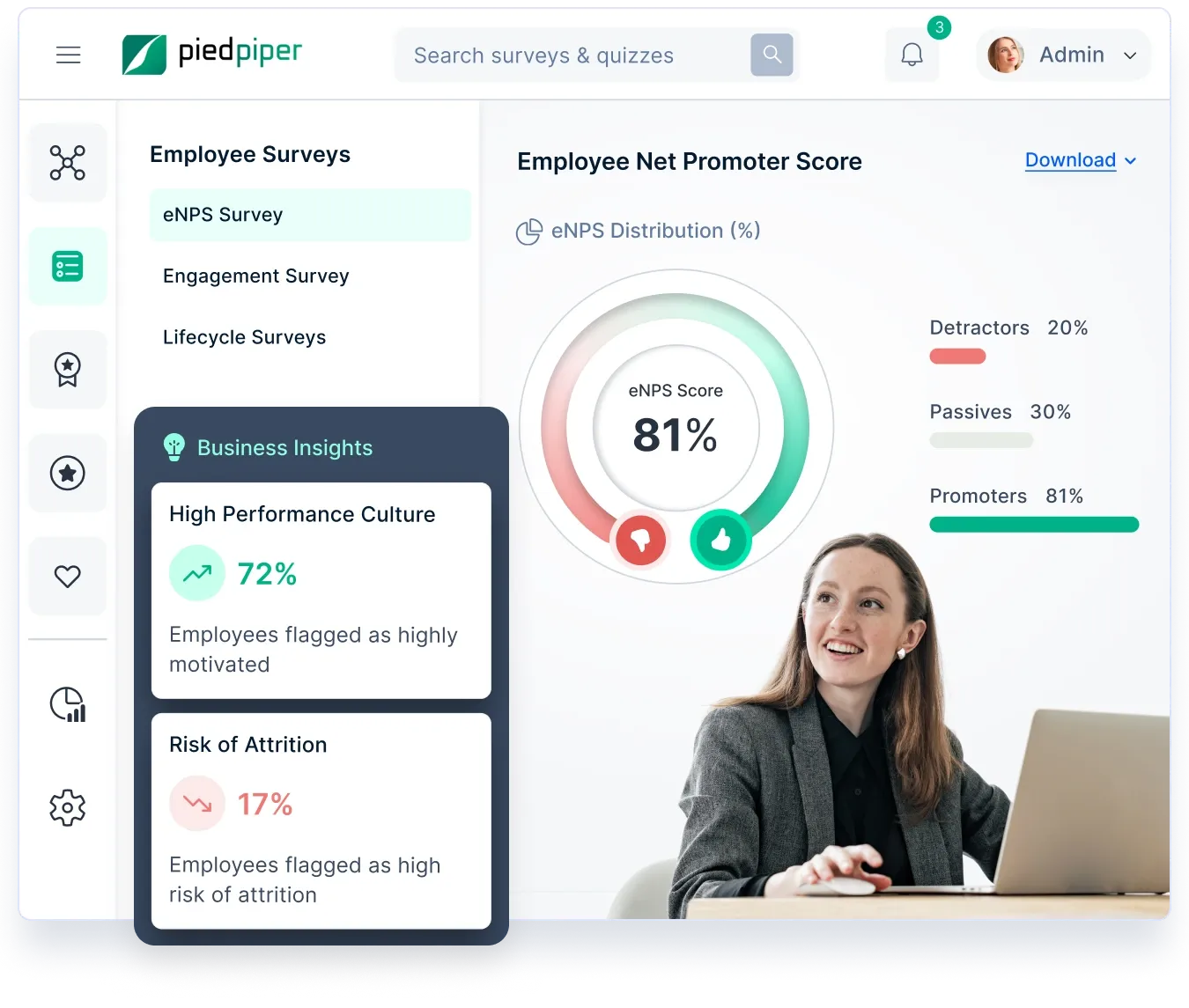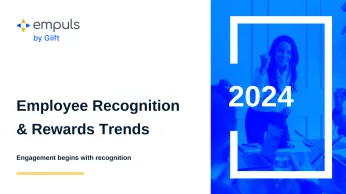Puntuación del Promotor Neto de los Empleados: Guía sobre el qué, el por qué y el cómo del eNPS
La puntuación neta del promotor del empleado (eNPS) es una métrica sencilla pero potente para medir la satisfacción y el compromiso de los empleados. En esta guía, exploramos cómo funciona eNPS, sus beneficios y cómo las empresas pueden aprovecharlo para crear una fuerza de trabajo más comprometida.
En esta página
- Comprender la puntuación neta del promotor de los empleados (eNPS)
- Ventajas de la puntuación del promotor neto de los empleados (eNPS)
- ¿Por qué las organizaciones deben prestar atención al eNPS?
- ¿Cómo calcular y aplicar la puntuación neta del promotor al compromiso de los empleados?
- Analizar los resultados de la encuesta sobre la puntuación neta de los promotores entre los empleados para mejorar el compromiso.
- Actuar sobre los resultados del eNPS para mejorar el compromiso de los empleados
- Encuestas eNPS Empuls : Mida y mejore la fidelidad de sus empleados con precisión
- Conclusión
- Preguntas frecuentes
"Para ganar en el mercado, primero hay que ganar en el lugar de trabajo", dijo Doug Conant, Director General de Campbell's Soup.
La opinión de Doug Conant no es un caso aislado para muchos directivos y consejeros delegados de éxito que entienden el valor de invertir en sus empleados.
El éxito de una empresa no es sólo cuestión de productos o beneficios: empieza por las personas que hay detrás. Los empleados comprometidos impulsan la innovación, fortalecen las relaciones con los clientes y fomentan el crecimiento a largo plazo. Pero, ¿cómo medir el compromiso más allá de suposiciones y corazonadas? Aquí es donde entra en juego la puntuación del promotor neto de los empleados (eNPS).
Originalmente diseñado para realizar un seguimiento de la lealtad de los clientes, el Net Promoter Score para el compromiso de los empleados ha evolucionado hasta convertirse en una métrica crucial para comprender la satisfacción en el lugar de trabajo. Las empresas que controlan y mejoran activamente el NPS de sus empleados obtienen beneficios tangibles: mayor retención, aumento de la productividad y una plantilla más comprometida. Los estudios demuestran que las organizaciones con empleados comprometidos obtienen un 27% más de beneficios, un 50% más de fidelidad de los clientes y un 15% menos de rotación de personal.
Al aprovechar el NPS de los empleados, las empresas obtienen información valiosa sobre lo que motiva a sus equipos, lo que les permite tomar decisiones informadas que fomentan un entorno de trabajo positivo. Un eNPS sólido no es sólo un número, es el reflejo de un lugar de trabajo en el que los empleados se sienten valorados y capacitados. En esta guía, explicaremos cómo utilizar el Net Promoter Score para el compromiso de los empleados para crear una plantilla más feliz y leal.
Comprender la puntuación neta del promotor de los empleados (eNPS)
Employee Net Promoter Score (eNPS) es una adaptación del tradicional Net Promoter Score (NPS) utilizado para medir la lealtad y la satisfacción de los empleados. eNPS consiste en formular a los empleados una sencilla pregunta:
"En una escala de 0 a 10, ¿qué probabilidad hay de que recomiende nuestra empresa como lugar de trabajo a un amigo o compañero?".
Las respuestas se clasifican en tres grupos:
- Promotores (9-10),
- Pasivos (7-8), y
- Detractores (0-6).
Los promotores son partidarios entusiastas que probablemente recomendarán la empresa. Los pasivos son empleados satisfechos pero poco entusiastas, vulnerables a las ofertas de la competencia. Los detractores son empleados descontentos que pueden influir negativamente en los demás y dañar la reputación de la empresa.
La sencillez y claridad del eNPS lo convierten en una valiosa herramienta para medir el compromiso. Proporciona una instantánea clara del sentimiento de los empleados, lo que permite a las empresas identificar rápidamente las áreas que necesitan mejoras. Mediante la medición periódica del eNPS, las organizaciones pueden hacer un seguimiento de los cambios en el compromiso de los empleados a lo largo del tiempo y evaluar el impacto de sus iniciativas destinadas a mejorar el entorno de trabajo.
Ventajas de la puntuación del promotor neto de los empleados (eNPS)
El seguimiento de la opinión de los empleados no sólo sirve para mantener contentos a los trabajadores, sino que repercute directamente en el rendimiento de la empresa. La puntuación del promotor neto de los empleados (eNPS) ayuda a las organizaciones a medir el compromiso, mejorar la retención y crear una cultura de trabajo próspera. A continuación le explicamos cómo esta sencilla pero potente métrica puede beneficiar a su empresa.
1. Medición clara del compromiso de los empleados
A muchas empresas les cuesta medir el grado de compromiso real de sus empleados. El NPS de los empleados simplifica esta tarea proporcionando una métrica directa que mide el sentimiento de los empleados. Un eNPS alto indica una plantilla motivada y satisfecha, mientras que una puntuación baja pone de manifiesto las áreas que necesitan mejoras.
2. Mejora de la retención de los empleados
Un sólido NPS de los empleados indica un entorno de trabajo positivo en el que los empleados se sienten valorados y escuchados. Las organizaciones que hacen un seguimiento de los datos de eNPS y actúan en consecuencia experimentan tasas de rotación más bajas, lo que reduce los costes de contratación y mantiene una plantilla estable y experimentada.
3. Mayor productividad y rendimiento
Los empleados comprometidos contribuyen más, trabajan con eficacia y están más comprometidos con los objetivos empresariales. Los estudios demuestran que las empresas con una mayor puntuación neta de promotores del compromiso de los empleados experimentan un aumento de la productividad, lo que se traduce en una mayor satisfacción de los clientes y un aumento de los ingresos.
4. Toma de decisiones basada en datos
En lugar de basarse en suposiciones, eNPS proporciona información procesable que ayuda a los equipos de RR.HH. y a la dirección a tomar decisiones informadas. Mediante el análisis de las tendencias de eNPS, las empresas pueden implementar estrategias que mejoren la cultura del lugar de trabajo, los beneficios y las prácticas de gestión.
5. Marca de empleador más fuerte
Un eNPS alto significa que es más probable que los empleados recomienden la empresa como un gran lugar para trabajar. Esto refuerza la reputación de la empresa, lo que facilita atraer a los mejores talentos y posicionarse como empleador preferente en un mercado laboral competitivo.
Utilizar la puntuación neta de los promotores de los empleados como un bucle de retroalimentación continua ayuda a las empresas a crear una cultura que da prioridad a los empleados. Cuando los empleados se sienten valorados, permanecen más tiempo, rinden más y contribuyen a que el lugar de trabajo prospere.
¿Por qué las organizaciones deben prestar atención al eNPS?
El eNPS no es sólo el nuevo niño en el bloque cuando se trata de métricas. Ha ofrecido resultados probados y comprobados. Por esta razón, algunas de las principales empresas de todo el mundo han adoptado el eNPS como parte de sus programas de interacción entre empleados y empleadores.
Muchos escépticos pasan por alto los beneficios de la puntuación neta de los promotores de los empleados y el hecho de que, aunque el eNPS por sí solo no pueda ayudar a aumentar los niveles de compromiso de los empleados, el mero hecho de que una organización realice encuestas periódicas de eNPS instala un sentimiento positivo de que la dirección está escuchando y está dispuesta a actuar en función de los comentarios de los empleados.
Esta percepción por sí sola puede sembrar la semilla para garantizar unos niveles de compromiso de los empleados por encima de lo normal, como se ha visto en varias historias de éxito.
1. Adobe
AdobeAdobe, una empresa líder de software, reconoció que mantener altos niveles de compromiso de los empleados era crucial para su innovación y éxito continuos. Sin embargo, se enfrentaban al reto de que los niveles de compromiso variaban entre los distintos equipos y departamentos.
Implantación de eNPS: Adobe introdujo eNPS como parte de su estrategia de compromiso de los empleados para recopilar información periódica. Realizaron encuestas trimestrales de eNPS para hacer un seguimiento del sentimiento de los empleados e identificar áreas de mejora.
Medidas adoptadas: Los comentarios revelaron que los empleados deseaban más oportunidades de desarrollo profesional y una comunicación transparente por parte de la dirección. En respuesta, Adobe puso en marcha varias iniciativas:
- Un completo programa de desarrollo profesional con itinerarios de aprendizaje personalizados y oportunidades de tutoría.
- Reuniones periódicas en los ayuntamientos y canales de comunicación transparentes en los que los líderes compartían información actualizada y abordaban las preocupaciones de los empleados.
Resultados: Con el tiempo, Adobe experimentó una mejora significativa en sus puntuaciones eNPS. Los empleados afirmaron sentirse más valorados y respaldados, lo que condujo a mayores niveles de compromiso. La empresa también observó un impacto positivo en la productividad y la innovación, con empleados más motivados para contribuir al éxito de Adobe.
2. Bain & Company
Bain & Companyuna empresa de consultoría de gestión global, quería asegurarse de que sus consultores, que a menudo trabajan en entornos muy estresantes, se sintieran comprometidos y apoyados.
Implantación de eNPS: Bain introdujo eNPS para medir periódicamente el sentimiento de los empleados e identificar las áreas que necesitan atención.
Medidas adoptadas: Los comentarios indicaron la necesidad de un mejor equilibrio entre la vida laboral y personal y más oportunidades de desarrollo profesional. Bain respondió implantando horarios de trabajo flexibles, promoviendo un equilibrio más saludable entre la vida laboral y personal, y ampliando sus programas de desarrollo profesional, incluyendo más sesiones de formación y oportunidades de crecimiento profesional.
Resultados: Bain experimentó una notable mejora en sus puntuaciones eNPS. Los empleados se sentían más equilibrados y apreciaban la inversión de la empresa en su crecimiento profesional. Esto condujo a mayores niveles de satisfacción laboral y retención.
3. Manzana
Apple, con su extensa red de más de 500 tiendas minoristas, necesitaba una forma de mantener altos niveles de compromiso de los empleados y de innovación en toda su diversa plantilla.
Implantación del eNPS: Apple adaptó el Net Promoter System®, utilizado tradicionalmente para medir la fidelidad de los clientes, para implicar a sus empleados. Acuñaron el término "Net Promoter for People" para captar este nuevo enfoque.
Medidas adoptadas: Utilizando los principios del Net Promoter System, Apple animó a los empleados a aportar sus ideas y comentarios, lo que dio lugar a numerosas innovaciones en las tiendas. Este enfoque animó a los empleados a aportar energía, entusiasmo y creatividad a sus funciones.
Resultados: La implantación de Net Promoter for People contribuyó al éxito minorista de Apple. Muchas innovaciones en las tiendas de Apple, como el Genius Bar y el programa Today at Apple, surgieron de las sugerencias de los empleados. Este empoderamiento dio lugar a una plantilla más comprometida, lo que a su vez mejoró la experiencia del cliente.
Aprovechando el sistema Net Promoter for People, Apple creó una cultura en la que los empleados se sentían valorados e inspirados. Esto no sólo mejoró la satisfacción de los empleados, sino que también se tradujo en un mejor servicio al cliente, una mayor fidelidad de los clientes y un aumento de las ventas. El éxito de este enfoque en Apple demuestra el poderoso impacto del uso de eNPS para fomentar un entorno de trabajo atractivo e innovador.
4. Microsoft
MicrosoftMicrosoft, un gigante mundial de la tecnología, se enfrentaba al reto de mantener altos niveles de compromiso entre los empleados de su amplia y diversa plantilla. El rápido ritmo de cambio e innovación provocaba a veces sentimientos de desconexión y agotamiento entre los empleados.
Implantación de eNPS: Microsoft implantó eNPS para medir regularmente el sentimiento de los empleados e identificar las áreas que necesitaban mejoras. Llevaron a cabo encuestas de eNPS dos veces al año para hacer un seguimiento de los niveles de compromiso y recopilar información procesable.
Medidas adoptadas: Los comentarios recibidos pusieron de manifiesto la necesidad de conciliar mejor la vida laboral y personal y de disponer de más oportunidades de crecimiento personal y profesional. En respuesta, Microsoft introdujo varias iniciativas:
- Mayor flexibilidad en las modalidades de trabajo, incluidas opciones de trabajo a distancia y horarios flexibles.
- Ampliaron sus programas de aprendizaje y desarrollo, ofreciendo una variedad de cursos y recursos para el desarrollo de habilidades.
- Mayor atención al bienestar de los empleados con programas de bienestar y apoyo a la salud mental.
Resultados: Estas acciones condujeron a una notable mejora de las puntuaciones eNPS. Los empleados afirmaron sentirse más equilibrados, apoyados y valorados. Este cambio positivo en el compromiso se tradujo en una mayor productividad, innovación y satisfacción laboral general.
5. ANCA Máquinas-herramienta
ANCA Máquinas-Herramienta reconoció la necesidad de un sistema de recompensas más transparente y coherente para impulsar el compromiso de los empleados. Su enfoque actual era irregular, lo que provocaba la falta de compromiso de los empleados. Para solucionarlo, ANCA decidió medir la satisfacción de los empleados y mejorar su compromiso mediante eNPS como parte de su estrategia más amplia de reconocimiento de los empleados.
Implementación de eNPS: ANCA Machine Tools integró Empuls no sólo para automatizar su sistema de recompensas, sino también para recopilar valiosos comentarios de los empleados a través de encuestas eNPS. La plataforma les permitió hacer un seguimiento de la satisfacción de los empleados y medir la probabilidad de que recomendaran la empresa como un gran lugar para trabajar. Estas encuestas periódicas proporcionaron información sobre las áreas de mejora y ayudaron a dar forma a sus estrategias de compromiso.
Medidas adoptadas:
- Lanzamiento de encuestas eNPS a través de Empuls para supervisar la satisfacción de los empleados y realizar un seguimiento del compromiso a lo largo del tiempo.
- Realización periódica de encuestas sobre el compromiso de los empleados para medir la eficacia del programa de recompensas y el ambiente de trabajo en general.
- Utilización de los resultados de eNPS para ajustar el programa de reconocimiento y abordar preocupaciones específicas de los empleados.
- Se racionalizó el proceso de nombramiento y recompensa, garantizando que los empleados recibieran un reconocimiento coherente basado en sus opiniones.
Resultados: Tras la implantación de las encuestas eNPS, ANCA Machine Tools vio cómo el 80% de los empleados se puntuaban a sí mismos como "promotores", lo que indicaba altos niveles de satisfacción. Además, se produjo un aumento del 100% en las puntuaciones de compromiso de los empleados, lo que refleja el impacto positivo del sistema de recompensas frecuente y transparente. El uso regular de eNPS ayudó a ANCA a mejorar continuamente sus iniciativas de compromiso de los empleados y a fomentar una conexión más fuerte entre la plantilla y la empresa.
6. Golfo Taleed
Gulf Taleeduna organización líder en Arabia Saudí, quería impulsar el compromiso y la retención de los empleados alineando a su plantilla con los valores fundamentales de la empresa. Para medir y mejorar la satisfacción de los empleados, necesitaban una forma coherente e imparcial de recopilar opiniones y realizar un seguimiento del compromiso en toda la empresa.
Implantación de eNPS: Gulf Taleed introdujo Empuls como una plataforma todo en uno para el compromiso de los empleados, centrándose en el uso de eNPS y encuestas de compromiso para medir el impacto del reconocimiento y el sentimiento general de los empleados. Estas encuestas proporcionaron información valiosa sobre la satisfacción de los empleados y ayudaron a identificar áreas de mejora.
Medidas adoptadas:
- Lanzamiento de encuestas eNPS a través de Empuls para medir periódicamente los niveles de satisfacción y compromiso de los empleados.
- Realización de encuestas a los nuevos empleados para obtener nuevas perspectivas sobre la cultura de la empresa y el proceso de incorporación.
- Integración de los resultados de la encuesta en la estrategia de reconocimiento de la empresa para adaptar mejor el reconocimiento a las opiniones de los empleados.
- Utilizó Empuls para rastrear y analizar las respuestas de eNPS, identificando patrones en la satisfacción de los empleados y áreas que requieren atención.
Resultados: Gracias a la plataforma Empuls , Gulf Taleed logró una tasa de cumplimentación del 70% de sus encuestas eNPS en un plazo de siete días. La información recopilada ayudó a dar forma a su estrategia de compromiso de los empleados, con más de 300 casos de reconocimiento entre compañeros registrados en sólo seis meses. Además, la empresa experimentó una mejora significativa en la retención de empleados, la moral y la alineación con los valores corporativos.
Los trabajadores felices y comprometidos ofrecen una hoja de ruta definitiva para el éxito de las empresas. El Employee Engagement Net Promoter Score ofrece una forma fácil y tangible de determinar los niveles de compromiso de los empleados, ayudando a las empresas a mantener un entorno de trabajo altamente atractivo que beneficia tanto a los empleados como a la dirección.
¿Cómo calcular y aplicar la puntuación neta del promotor al compromiso de los empleados?
Medir y mejorar el compromiso de los empleados empieza por comprender cómo se sienten en su lugar de trabajo. La puntuación neta de promotores de los empleados (eNPS) proporciona una forma sencilla pero eficaz de medir el sentimiento, seguir las tendencias y tomar medidas. A continuación se explica cómo calcular y aplicar eNPS para crear una plantilla más comprometida.
Cálculo del eNPS para el compromiso de los empleados
La puntuación del promotor neto de los empleados (eNPS) se calcula mediante una fórmula sencilla. Una vez que los empleados responden a la pregunta "¿Qué probabilidades hay de que recomiende nuestra empresa como lugar de trabajo a un amigo o compañero?", sus respuestas se clasifican en promotores (9-10), pasivos (7-8) y detractores (0-6). La puntuación final del eNPS se obtiene restando el porcentaje de detractores del porcentaje de promotores, mientras que los pasivos se excluyen del cálculo.
Dado que los resultados de eNPS pueden variar en función de cuándo y cómo se formule la pregunta, las empresas adoptan distintos enfoques, recopilando opiniones mensual, trimestral o anualmente para realizar un seguimiento eficaz de las tendencias. La escala de puntuación va de -100 a 100. Las puntuaciones por encima de 50 se consideran excelentes, de 10 a 30 buenas y cualquier puntuación por debajo de cero indica la necesidad de tomar medidas inmediatas.
Aunque el eNPS es una métrica valiosa para medir el sentimiento de los empleados, no debe considerarse de forma aislada. Comparar los resultados a lo largo del tiempo proporciona una imagen más clara de las tendencias de compromiso y permite a las empresas ajustar sus estrategias en consecuencia. Las evaluaciones periódicas, idealmente trimestrales, ayudan a las organizaciones a tomar el pulso a la satisfacción de los empleados y a abordar los problemas de forma proactiva.
Implantación del eNPS para el compromiso de los empleados
La implementación de eNPS requiere un enfoque estructurado para garantizar una información precisa y una acción significativa. A continuación se explica cómo las empresas pueden implementar eficazmente una encuesta de eNPS.
1. Diseño de la encuesta
La pregunta principal de eNPS debe ser sencilla y directa: "¿Qué probabilidades hay de que recomiende nuestra empresa como lugar de trabajo a un amigo o compañero?". Para obtener una visión más profunda, haga un seguimiento con preguntas abiertas como "¿Cuál es la razón principal de su puntuación?" o "¿Qué mejoras mejorarían su experiencia?".
2. Seleccionar las preguntas adecuadas
Para que el eNPS sea más práctico, las preguntas deben ser fáciles de entender y centrarse en los factores clave del compromiso, como la satisfacción en el trabajo, el entorno laboral, el liderazgo y las oportunidades de desarrollo profesional.
3. Elegir la frecuencia de encuesta adecuada
Para hacer un seguimiento eficaz de la participación, las encuestas eNPS deben realizarse a intervalos regulares (trimestrales o semestrales) para controlar las tendencias y evitar la fatiga de la encuesta. Las encuestas demasiado frecuentes pueden dar lugar a una menor participación y a respuestas menos sinceras.
4. Fomentar los comentarios sinceros y constructivos
El anonimato es clave para obtener respuestas sinceras. Los empleados deben tener la seguridad de que sus comentarios son confidenciales y se utilizan para mejorar el lugar de trabajo. Comunicar claramente el propósito de la encuesta fomenta la transparencia y la confianza.
5. Análisis de los resultados de eNPS
Una vez calculado el eNPS, las empresas deben ir más allá de la puntuación y analizar patrones en las respuestas. Desglosar los datos por departamentos, niveles de empleo o datos demográficos puede descubrir problemas específicos que requieren atención.
6. Actuar en función de las reacciones e impulsar el cambio
eNPS sólo es valioso si las organizaciones actúan en consecuencia. Los equipos de RR.HH. y de dirección deben desarrollar planes de acción para abordar las principales preocupaciones planteadas en la encuesta. Compartir información actualizada sobre las mejoras realizadas ayuda a reforzar la confianza y demuestra a los empleados que sus opiniones cuentan. El seguimiento regular y los ajustes basados en los comentarios continuos garantizan una mejora continua del compromiso.
Una estrategia de puntuación del promotor neto de los empleados bien aplicada no sólo mide el compromiso, sino que también proporciona una hoja de ruta para crear un lugar de trabajo en el que los empleados se sientan valorados, escuchados y motivados para contribuir al éxito de la empresa.

Recoger la opinión de los empleados es sólo el primer paso: lo importante es convertirla en un cambio significativo. Empuls agiliza la implementación de eNPS con encuestas personalizables, programación automatizada y análisis en tiempo real, ayudando a las organizaciones a captar los sentimientos honestos de los empleados sin complicaciones.
Con opciones de feedback anónimo y perspectivas basadas en IA, Empuls facilita la identificación de tendencias de compromiso y señala áreas de mejora. La plataforma no solo mide el compromiso, sino que ayuda a los equipos de RRHH y de liderazgo a tomar medidas para garantizar que los empleados se sientan escuchados y valorados.
Analizar los resultados de la encuesta sobre la puntuación neta de los promotores entre los empleados para mejorar el compromiso.
Una vez completada la encuesta eNPS y recopilados los datos, el siguiente paso crucial es analizar los resultados. Un análisis eficaz puede proporcionar una visión profunda de los niveles de compromiso de los empleados y señalar áreas específicas de mejora.
1. Calcular la puntuación eNPS
Para calcular el eNPS, reste el porcentaje de detractores del porcentaje de promotores. Así se obtiene una única puntuación que representa el sentimiento general de la plantilla. Una puntuación positiva indica más promotores que detractores, mientras que una puntuación negativa sugiere lo contrario.
Ejemplo: Si el 60% de los empleados son promotores y el 20% son detractores, la puntuación eNPS sería 40.
2. Identificar tendencias y pautas
Busque temas comunes en las respuestas. ¿Hay cuestiones concretas que los detractores mencionen con frecuencia? ¿Los promotores destacan aspectos concretos del lugar de trabajo? Identificar estas tendencias puede ayudar a priorizar las áreas que necesitan atención inmediata.
Ejemplo: Si los detractores mencionan a menudo la falta de oportunidades de desarrollo profesional, mientras que los promotores alaban el entorno de trabajo colaborativo, estas percepciones orientan hacia dónde centrar los esfuerzos de mejora.
3. Segmentar los datos
Desglose los resultados por diferentes segmentos, como departamentos, niveles de empleo o ubicaciones. Esto puede revelar retos o puntos fuertes dentro de grupos específicos. Por ejemplo, un departamento puede tener un alto nivel de compromiso mientras que otro tiene dificultades, lo que indica dónde son necesarias intervenciones específicas.
Ejemplo: Si el departamento de ventas tiene un eNPS significativamente más bajo en comparación con el departamento de marketing, puede indicar problemas específicos del entorno de trabajo o del estilo de gestión del equipo de ventas.
4. Evaluar las respuestas abiertas
Preste mucha atención a las respuestas abiertas. Estos comentarios aportan contexto a las puntuaciones y pueden ofrecer información valiosa que las cifras por sí solas no pueden ofrecer. Los empleados suelen compartir sugerencias concretas y comentarios detallados que pueden orientar los esfuerzos de mejora.
Ejemplo: Una respuesta abierta puede revelar que los empleados se sienten sobrecargados de trabajo durante las temporadas altas. Este dato puede llevar a explorar soluciones como una mejor asignación de recursos o la contratación adicional durante los periodos de mayor actividad.
5. Comparación con resultados anteriores
Compare la puntuación eNPS actual con puntuaciones anteriores para realizar un seguimiento de los cambios a lo largo del tiempo. Esto ayuda a evaluar el impacto de cualquier iniciativa o cambio implementado desde la última encuesta. Una tendencia al alza indica mejoras, mientras que una tendencia a la baja señala posibles problemas que deben abordarse.
Ejemplo: Si la puntuación eNPS mejoró de 20 a 35 en un año, sugiere que los esfuerzos recientes para mejorar el compromiso de los empleados han sido eficaces.
6. Compartir y debatir los resultados
Presente los datos analizados a la dirección y a las partes interesadas pertinentes. Compartir los resultados de forma transparente ayuda a generar confianza y demuestra el compromiso de actuar en función de los comentarios. Entablar conversaciones para elaborar planes de acción basados en las conclusiones del análisis.
Ejemplo: Organizar una asamblea general en la que se compartan los resultados con toda la empresa, seguida de sesiones de grupo para debatir áreas específicas de mejora.
Un análisis exhaustivo de los resultados de eNPS es esencial para comprender el compromiso de los empleados y tomar medidas informadas para mejorar el entorno de trabajo. Al centrarse en las tendencias, segmentar los datos y evaluar los comentarios detallados, las organizaciones pueden tomar decisiones estratégicas para fomentar una plantilla más comprometida y satisfecha.
Actuar sobre los resultados del eNPS para mejorar el compromiso de los empleados
Después de recopilar y analizar las opiniones de eNPS, el paso más importante es actuar sobre la base de los conocimientos obtenidos. Aplicar cambios basados en las opiniones de los empleados demuestra que la organización valora las opiniones de sus empleados y está comprometida con la mejora continua.
1. Elaborar planes de acción
A partir de la información recibida, elabore planes de acción específicos para abordar los problemas detectados. Dé prioridad a las áreas que tengan un impacto más significativo en el compromiso de los empleados. Asegúrese de que estos planes sean prácticos y realizables en un plazo razonable.
Ejemplo: Si los comentarios indican la necesidad de mejores oportunidades de desarrollo profesional, elabore un programa completo de formación y desarrollo que incluya talleres, tutorías y trayectorias profesionales claras.
2. Comunicar los cambios
La transparencia es clave para mantener la confianza. Informe a los empleados sobre los comentarios recibidos y las medidas que se están tomando para abordar sus preocupaciones. Las actualizaciones periódicas sobre el progreso de estas iniciativas ayudan a mantener a los empleados comprometidos e informados.
Ejemplo: Envíe un correo electrónico a toda la empresa en el que se detallen los planes de acción derivados de la encuesta eNPS y facilite un calendario sobre cuándo pueden esperar los empleados ver los cambios.
3. Fomentar una cultura de retroalimentación continua
Fomente el diálogo permanente entre los empleados y la dirección. Facilite que los empleados compartan sus opiniones y sugerencias al margen de las encuestas formales. Los controles periódicos y las sesiones de feedback pueden ayudar a identificar problemas antes de que se conviertan en problemas importantes.
Ejemplo: Establecer un buzón de sugerencias anónimo o una plataforma digital de comentarios donde los empleados puedan compartir continuamente sus ideas y preocupaciones.
4. Supervisar y ajustar los planes
Revise periódicamente la eficacia de los cambios aplicados. Utilice encuestas eNPS posteriores para evaluar si las medidas adoptadas han tenido un impacto positivo en el compromiso de los empleados. Prepárese para realizar ajustes en función de los comentarios y las necesidades cambiantes.
Ejemplo: Si el nuevo programa de desarrollo profesional recibe comentarios positivos, pero los empleados siguen expresando su preocupación por el equilibrio entre la vida laboral y personal, plantéate iniciativas adicionales para abordar esta cuestión, como horarios de trabajo flexibles u opciones de trabajo a distancia.
5. Reconocer y recompensar las mejoras
Reconozca y celebre las mejoras en el compromiso de los empleados. Reconocer a los departamentos o equipos que muestran cambios positivos significativos puede motivar a otros y reforzar la importancia de las iniciativas de compromiso.
Ejemplo: Celebrar un evento de reconocimiento para celebrar los departamentos que han logrado avances significativos en la mejora de sus puntuaciones de eNPS, destacando las acciones específicas que condujeron a su éxito.
6. 6. Participación de los dirigentes
Asegúrese de que la dirección participa activamente en el proceso. Los directivos no sólo deben apoyar las iniciativas de compromiso, sino también defenderlas. Su implicación subraya la importancia del compromiso de los empleados para el éxito general de la organización.
Ejemplo: Haga que los altos directivos organicen reuniones periódicas para debatir iniciativas de compromiso y abordar personalmente las preocupaciones y opiniones de los empleados.
Al actuar en función de los comentarios de eNPS, las organizaciones pueden crear un bucle de retroalimentación positiva que mejore continuamente el compromiso de los empleados. Este enfoque proactivo conduce a una plantilla más motivada, satisfecha y productiva, lo que en última instancia impulsa el éxito de la organización.
Encuestas eNPS Empuls : Mida y mejore la fidelidad de sus empleados con precisión

Las encuestas eNPS (Employee Net Promoter Score) Empuls son una poderosa herramienta para medir la lealtad y satisfacción de los empleados sin esfuerzo. Se centran en una pregunta clave: "¿Qué probabilidad hay de que recomiende esta organización como un gran lugar para trabajar?".
Este enfoque sencillo pero eficaz le ayuda a identificar a los promotores (empleados entusiastas), los pasivos (empleados neutrales) y los detractores (empleados descontentos), ofreciéndole una imagen clara del entorno de su lugar de trabajo.
- Rápido y sin complicaciones: Envíe encuestas de tamaño reducido que se rellenan en menos de un minuto, lo que garantiza altos índices de participación.
- Plantillas personalizables: Adapta las preguntas de la encuesta a los objetivos y la cultura de tu organización.
- Análisis en tiempo real: Obtenga información instantánea con paneles de fácil lectura que destacan las tendencias del sentimiento de los empleados.
- Seguimiento automático: Configura recordatorios automáticos para atraer a los empleados que aún no han respondido.
- Comentarios útiles: Identifique las áreas clave de mejora basándose en los comentarios y sugerencias detallados de los empleados.
- Capacidades de evaluación comparativa: Compare sus puntuaciones de eNPS entre equipos, departamentos o estándares del sector.
Comprender su eNPS ayuda a crear una plantilla más comprometida, motivada y leal.
¿Listo para impulsar el compromiso de los empleados?
Descubra cómo las encuestas eNPS Empuls pueden ayudarle a convertir los comentarios en acciones. ¡Empieza hoy mismo con Empuls !
Conclusión
El compromiso de los empleados es crucial para el éxito de la organización. El uso de la puntuación del promotor neto de los empleados (eNPS) proporciona información valiosa sobre el sentimiento de los empleados y pone de relieve las áreas de mejora. eNPS es una métrica directa que mide la lealtad y la satisfacción de los empleados, orientando a las empresas en la mejora de su entorno de trabajo.
La aplicación del eNPS implica el diseño de la encuesta, la selección de las preguntas pertinentes, la elección de la frecuencia adecuada, el fomento de una opinión sincera, el análisis de los resultados y la adopción de medidas basadas en la opinión de los encuestados. Este enfoque promueve la mejora continua y la comunicación abierta, aumentando el compromiso y la productividad.
Los casos prácticos de Tech Innovators Inc, Global Retail Solutions, HealthCare Plus y Financial Services Group muestran cómo el eNPS puede abordar retos específicos y mejorar significativamente el compromiso de los empleados.
eNPS es una poderosa herramienta para fomentar una plantilla más comprometida. Las organizaciones pueden crear un entorno de trabajo positivo que impulse el éxito escuchando a los empleados y realizando cambios significativos. Empiece a utilizar eNPS en su organización hoy mismo para impulsar el compromiso y la satisfacción de los empleados. Concierte una llamada con los expertos de Empuls .
Preguntas frecuentes
1. ¿Qué es una buena puntuación del promotor neto de los empleados (eNPS)?
Una buena puntuación del promotor neto de los empleados (eNPS) suele situarse entre 10 y 30, lo que indica un nivel saludable de satisfacción y lealtad de los empleados. Las puntuaciones por encima de 50 se consideran excelentes y muestran una plantilla muy comprometida, mientras que las inferiores a 0 indican insatisfacción y la necesidad de mejoras inmediatas.
2. ¿Cómo se calcula el eNPS?
El eNPS se calcula restando el porcentaje de detractores (puntuaciones 0-6) del porcentaje de promotores (puntuaciones 9-10).
3. ¿Por qué es importante el eNPS para el compromiso de los empleados?
eNPS proporciona una medida clara y cuantificable del sentimiento de los empleados, lo que ayuda a las organizaciones a identificar áreas de mejora y realizar un seguimiento de los cambios a lo largo del tiempo.
4. ¿Con qué frecuencia deben realizarse las encuestas eNPS?
Las encuestas eNPS deben realizarse a intervalos regulares, como trimestral o bianualmente, para controlar las tendencias y realizar los ajustes oportunos.
5. ¿Cuáles son algunas de las preguntas de seguimiento que se suelen incluir en una encuesta eNPS?
Las preguntas de seguimiento pueden incluir: "¿Cuál es la razón principal de su puntuación?" y "¿Qué podríamos hacer para mejorar su experiencia?".
6. ¿Cómo podemos asegurarnos de que los empleados proporcionen opiniones sinceras en las encuestas eNPS?
Asegure a los empleados que sus respuestas permanecerán anónimas y comunique claramente el propósito de la encuesta.
7. ¿Qué debemos hacer si nuestra puntuación eNPS es baja?
Analice los comentarios para identificar problemas concretos, elabore planes de acción específicos y comunique los cambios a los empleados para dar respuesta a sus preocupaciones.
8. ¿Puede utilizarse el eNPS en todo tipo de organizaciones?
Sí, el eNPS es versátil y puede utilizarse en diversos sectores y tamaños de organización para medir el compromiso de los empleados.
9. ¿Cómo podemos actuar eficazmente a partir de los comentarios de eNPS?
Elabore planes de acción basados en los comentarios, comunique los cambios y revise y ajuste periódicamente estos planes en función de los comentarios y resultados continuos.
10.¿Cuáles son las ventajas de utilizar eNPS frente a otras métricas de compromiso?
eNPS es sencillo, fácil de entender y proporciona una instantánea clara del sentimiento de los empleados. Además, fomenta una cultura de retroalimentación y mejora continuas.













